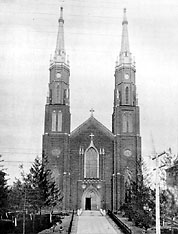CITYSCAPES
Church of churches
By KEVIN LEININGER
from the archives of The News-Sentinel
To look at these two pictures closely, you'd almost think there have been
two different cathedrals. One photograph shows a brick church built in an
ornate French Gothic style, a large stained-glass window gracing the front
wall. The other shows a church built of bright Wisconsin Lannonstone, its
style the more streamlined German Gothic. The window has been replaced by a
statue of the Virgin Mary.
|
 |

|
The most visible church in this ``city of churches'' is the Cathedral of the Immaculate Conception, which has experienced its share of architectural transfigurations since it was dedicated in 1860.
The Cathedral - the first of Fort Wayne's Catholic churches - was designed
by Father Julian Benoit, a Frenchman who came to Fort Wayne in 1840. The first
brick was laid on July 10, 1859. Fifteen months and $54,000 later, the
Cathedral was completed.
On Dec. 15, 1860, The Fort Wayne Sentinel reported that ``The Catholics of
this city have reason to congratulate themselves upon having such a fine
structure as a place of worship, in which the ceremonies of their church may
be performed with the impressive solemnity that attracts even those who do not
attach the same importance on them Catholics do.''
Even though the reporting was a little slanted, you couldn't argue with the
paper's conclusion: the new Cathedral was a ``beautiful monument to ornament
the city.''
About $50,000 worth of remodeling was done in 1897, and during the 11-year
tenure of Monsignor John R. Quinlan (1910-1921), the original brick exterior,
which had started to corrode, was replaced with an imitation rock face of
molded cement. By the late 1940s, though this ``sham-rock'' as it was
sometimes called began to fall off and constituted a hazard to the public
health.
To correct the problem and to harmonize the Cathedral with the new
MacDougal Chapel going up in Cathedral Square, Monsignor John Dapp began the
renovation project which gave the church the face it wears today. Between 1949
and 1950, huge wooden scaffolds obscured the old Cathedral, as most of the old
cement covering was removed and replaced with 2,000 tons of stone from
Wisconsin and Indiana quarries.
The stone was anchored to the original bricks and was built on its own
foundation. The stone refacing cost $256,649 in 1950 but would cost an
estimated $1.3 million today.
The Cathedral's twin spires - its most unique feature - were also altered.
But despite all the changes over the years, the spires - and the Cathedral
itself - remain a recognizable landmark in a downtown which is constantly
changing.
--Jan. 16, 1982

